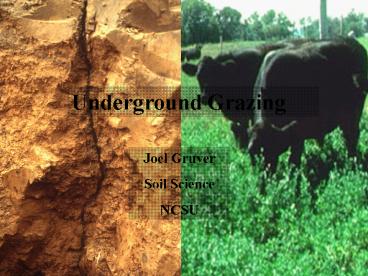Underground Grazing PowerPoint PPT Presentation
1 / 37
Title: Underground Grazing
1
Underground Grazing
Joel Gruver Soil Science NCSU
2
Zone of earthworm influence burrows, galleries,
diapause chambers, surface and subterranean
casts, middens
What is the drilosphere ?
Functionally similar to the rhizosphere and
detritusphere
3
surface casts
http//www.sciencebuddies.org/mentoring/project_id
eas/PlantBio_p002.shtml?fromHome
4
Middens
5
Diapause chamber in East Texas soil
SSSAJ 69(3) cover
6
Earthworm functional continuum Epigeic ?
Anecic ? Endogeic
7
Which burrows were made by an endogeic ?
Capowiez et al. 2003)
8
Earthworm Taxonomy More than 3500 species of
earthworms have been identified worldwide 12
families of earthworms in the US and Canada
150 total species 45 are exotic species 25 are
exotic Lumbricids from Europe
9
Earthworms in North Carolina An extensive survey
(sites in 80 counties) was conducted by Dr. John
Warren Reynolds in the early 1990s. 42 species of
earthworms were found. The results of this survey
and surveys of the earthworms present in many
other states can be found in the journal
Megadrilogica .
10
Peer-reviewed proceedings from a 1993
international conference. Topics discussed
include How has glaciation affected earthworm
distribution in North America ? How do native
and exotic species impact natural and
agroecosystems ? How has earthworm taxonomy
changed over time ?
BIOGEOGRAPHY
11
Native Earthworm genera in the SE
Sparganophilus
Bimatos
Eisenoides
Diplocardia
12
Earthworm identification can be tricky !
13
Earthworm anatomy
14
Key features for identifying worms
15
Internal anatomy
16
- Allolobophora chlorotica
- (Green Worm)
- Native to northern Europe
- Color varies from green to yellow, pink, or gray
- 30-70 x 3-5 mm
- Found in a wide range of soil types, mainly on
wet, highly organic or polluted sites - Endogeic, largely geophagous
- Matures at 120-130 days
- Casting and mating occur beneath the soil
- Facultative diapause
- Sluggish rolls into spiral when disturbed
17
Amynthas diffringens (Snake worm, Crazy worm)
- Native to Southern Asia
- Widely distributed in warm climates, tolerates
heat and drought - 45-170 x 3-6 mm
- Parthenogenetic reproduction
- Endogeic, some detritivory at soil surface
- Very fast moving, lashes about when disturbed,
often sheds "tail" which continues to lash about
while the rest of the earthworm escapes
18
- Aporrectodea trapezoides
- (Southern Worm)
- Paleartic origin
- Color variable, from slate gray to pink,
flattenable posterior - 80-137 mm x 3-7 mm contracted, 220 x 3-5 mm
relaxed - Parthenogenetic reproduction
- Dormancy spent rolled in a ball in an oval
chamber - Found in heavy or sandy soil
- Endogeic and mainly geophagous, but some
individuals forage on surface detritus casting
at soil surface - Tolerates immersion in water
19
Lumbricus terrestris, Night Crawler
20
Eisenia fetida, Red wiggler
21
(No Transcript)
22
In 1881, Darwin reported that healthy earthworms
sometimes leave their burrows at night and embark
on a voyage of discovery
Surface migration by earthworms is a routine
activity aimed at dispersal and finding a mate.
Surface migration usually occurs during cloudy
moist conditions. Both anecic and endogeic
earthworms are active surface migrants.
23
Earthworm sex
24
Earthworm cocoons
http//soils.usda.gov/sqi/soil_quality/soil_biolog
y/images/CE8a-cocoon_LR_small.jpg
25
How do earthworms affect pastures ?
Annual production of surface casts typically
ranges from 1 25 kg / m2
in temperate pastures.
26
Some effects of Aporrectodea caliginosa on the
properties of a pasture soil in Otago, NZ
(Stockdill, 1982)
27
Impact of earthworms on SOM dynamics
Ingested soil
Fresh casts
Aging casts
Soil profile
Nutrient release
Assimilation Comminution
Physical protection
Sequestration ??
(Lavelle and Spain, 2001)
28
Studying earthworms in pasture systems
http//www.ucd.ie/agbiota/action/studies.htm
29
Using plaster of paris to study earthworm burrows
Expelling earthworms using an irritant solution
(formalin, mustard)
30
Collecting soil for 3 dimensional analysis of
earthworm burrows
31
Expelling earthworms using an electro-shock
technique
32
Optimizing the earthworm community in a pasture
soil Keep pastures well limed (maintain soil pH
gt 5.5) Minimize use of pesticides Fertilize to
increase pasture productivity Avoid ammonium
based fertilizers Maintain legumes
Irrigate Inoculate with earthworms
33
How many worms should be in a pasture soil ?
Hendrix et al. (2003)
34
When are earthworms most active ?
Syers et al. (1978)
35
- A minimum target earthworm community
(Lee, 1991) - one or more anecic or anecic/epigeic species
that make subvertical burrows, feed on litter and
deposit casts at the surface - one or more endogeic species that feed on dead
roots and other subsurface organic matter and
make randomly oriented burrows - at least one species that makes deep burrows and
can penetrate compact soil layers
36
- New Zealand earthworm inoculation
strategy - Identify areas with high earthworm populations
(e.g., near homesteads,
orchards, shelterbelts, areas that are greener
in spring). Source areas should have at least 500
earthworms per square yard for maximum
establishment rates - Cut turves (9 x 9 x 2).
- Distribute turves ( 30 apart and upside down)
after a period of rain when soil is moist. - Earthworms will move down into moist pasture soil
as turves dry
37
Any Questions ?

